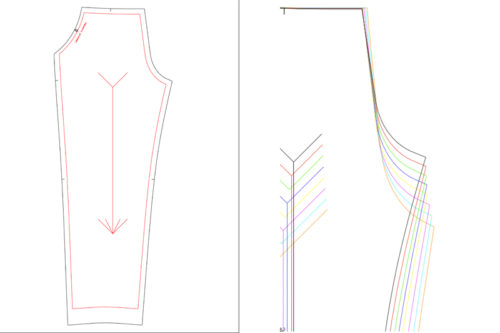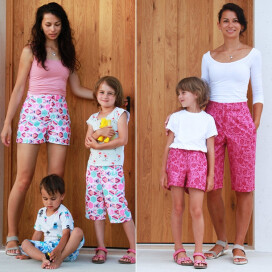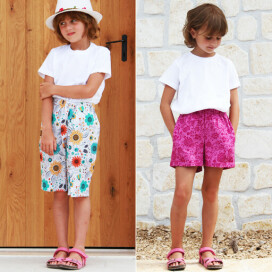Difficulty level
This pattern is very simple, so even absolute beginners should be able to handle it.How to sew simple baby sweatpants with round crotch
You can find detailed sewing instructions in this article:How to sew simple baby trousers / baby leggings with round crotch
Recommended material
This pattern works best with thin and medium knits (elastic materials - elastic cotton knits, French Terry, Ponte Roma, Punto di Prada, thin uncombed tracksuit fabric with elastane...). You can use materials of different densities (weights), but I would not go over 240g / m2. In any case, there should be elastic fibers in your material (elastane, lycra, etc.). I’ve bought fabrics for my baby patterns collection at Dumlatek.cz. All of them are cotton knits. You can take a look at this particular fabric (with white drops on petrol) here:Required amount of material
(for 140 cm wide fabric)- Sizes 50 - 68: 50 cm
- Sizes 72 - 86: 60 cm
Simple pattern for baby sweatpants with round crotch
There are three versions of this pattern (you will receive all of them after purchase):- 1st version (one size view) – PDF A4 – pattern in individual sizes with seam allowances outlined– all individual sizes of the pattern (pattern of each size shows sewing lines and seam allowances are outlined too).
- 2nd version (classic view) – PDF A4 pattern showing all sizes without seam allowances - all sizes are outlined “in one picture”(each in its own color) without seam allowances.
- You can choose what works best for you. The advantage of the classic view (where all the sizes are shown) is that you can easily customize your pattern to fit body types in between the chart sizes. One size view saves time during preparation - you do not have to think where and how much to add for the seams, because everything is already there.
- 3rd version (classic view) – PDF A1 pattern showing all sizes without seam allowances. This large format pattern does not need to be glued together. You can print it on a home or office plotter or in one of the many copy centers.
 What a pattern from Picolly.com looks like
What a pattern from Picolly.com looks like
When and how do I receive my pattern?
After the payment has been credited to the account, I will immediately send the pattern with sewing instructions in PDF format to your e-mail address. Then you just need to print and assemble the pattern of desired size. Check out my article on how to assemble the paper pattern from A4 pages.Size chart
- (NB = Newborn)
- The size of the pattern for babies and small children should be chosen according to their height.
Babies & Toddlersmeasurements are in centimeters (without diapers) |
|||||||||||||||
| Size | NB - 50 | 56 | 62 | 68 | 74 | 80 | 86 | ||||||||
| Height | up to 50 | 51 – 56 | 57 – 62 | 63 – 68 | 69 – 74 | 75 – 80 | 81 – 86 | ||||||||
| Chest | 42 | 44 | 45 | 46 | 48 | 50 | 52 | ||||||||
| Waist (Belly) | 45 | 46 | 47 | 48 | 49 | 50 | 52 | ||||||||
| Hips | 46 | 48 | 50 | 52 | 54 | 55 | 56 | ||||||||
Declaration
Pattern, including instructions and all photographs, is a copyrighted work and any distribution, copying or disclosure to third parties is prohibited and will be considered a violation of the Copyright Act (Copyright Act, Act No. 121/2000 Coll. / Zákon o právu autorském – Zákon č. 121/2000 Sb., Česká republika), which may be prosecuted. Contents of the pattern (and instructions) are based on personal experiences of the author. Your personal successes and possible failures are in your hands and the author bears no responsibility for them. But that doesn’t mean you’re on your own. Whenever you need advice, please do not hesitate to contact me at petra@picolly.comNotice to companies
The pattern is not intended for commercial use. If you are a tailor (for example) and you want to use any of my patterns for commercial purposes, please do not hesitate to contact me. I will be happy to discuss my options with you and create a bespoke offer for you.For best results, please read the following:
- The patterns are constructed in ready-made sizes, because it is not possible to construct a pattern for all body types (the size chart would get too congested).
- To make the clothes fit the individual figure perfectly, you need to carefully measure it first. Then compare measurements with size chart, and paper pattern. That is the only way to find best pattern size.
- In addition, it’s almost always necessary to adjust the pattern slightlyto make it fit perfectly. (Even if we have two women whose measurements are the same, they will differ in other ways – one of them may have a narrower back and a larger bust, the other may be more muscular with smaller bust. One of them may also have wider hips and flatter buttocks, the other may have narrower hips and rounder buttocks…) Patterns (and their sizes) are only rough guidelines. If you are going for perfect fit, you need to perform fitting tests and adjust the garments accordingly. Sewing is a creative activity and you need to take into account that each of us is built differently. THIS APPLIES TO CHILDREN’S AND MEN’S CLOTHES TOO – WE ARE ALL UNIQUE.
- If you are using some pattern for the first time, always sew “test sample” from a cheaper fabric first. Mark any adjustments in the paper pattern and then use it to sew the final product. It is a classic tailoring method. No two fabrics are the same, therefore, please note that what works with one fabric may not work with another. That is why you should always sew test samples. Sewing is not like baking, you can’t just pick the pattern and expect the perfect results without some measuring, testing and adjusting. That’s just how it works.
- I also recommend temporarily stitching all seams that affect circumferences (such as side seams, instep seams, etc.) before sewing. So, you can try the garment on and adjust it if necessary. Do not underestimate ironing and testing the clothes during the sewing process.
- Also don’t forget to carefully mark seam allowances. Beginners often forget about them. It is necessary to measure seam allowanceswith the measuring tape around the entire pattern and then sew along the correct sewing lines – seam allowances width away from the cutting edges. Careless work with the seam allowances can result in large deviations in the overall widths and lengths of the individual pieces.
- When positioning the paper pattern pieces always make sure that the pieces are oriented correctly.
Free patterns:
Not sure whether to buy a pattern? Not sure what the pattern will look like and if you ever be able to put it together? Download one of my patterns for free and see what it looks like and try using it. Free patterns are in the same format as the patterns available in the store. You check them out here:Worth reading:
- How to assemble the paper pattern
- How to transfer the paper pattern to the fabric
- How to adjust the pattern
- How to scale the pattern proportionally
- How to baste the fabric
- How to choose sewing machine needle
- Sewing elastic fabrics with regular sewing machine – 4 steps to success
- 5 sewing tools that you cannot buy in the haberdashery
- How to choose a sewing machine – 5 important tips








































